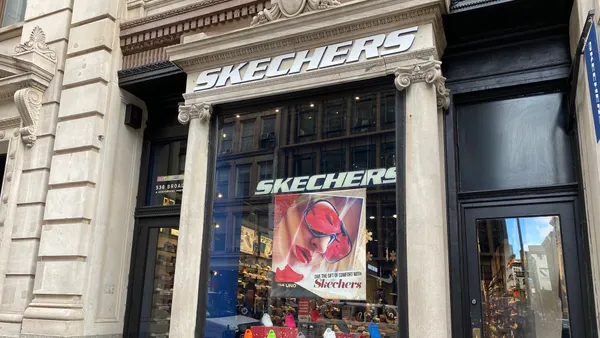Dive Brief:
- J.C. Penney on Thursday reported that second quarter net sales fell 7.5% year over year to $2.8 billion while comparable store sales ticked slightly positive at 0.3%, according to a press release. The company said the top-line sales decline was primarily due to the 141 stores that closed in fiscal 2017.
- The department store retailer's net loss widened in Q2 to $101 million, more than double last year's Q2 loss. Shares of J.C. Penny fell 22% in premarket trading as the company's comps fell below analyst estimates (the FactSet consensus was 1%) and its losses were worse than analysts expected, according to MarketWatch. Executives also reduced their earnings guidance for the year, now expecting flat comps and a loss of up to $1 per share.
- Penney said in Q2 that its children's, jewelry, Sephora, women's apparel and salon sales were the retailer's strongest performing categories. Women's apparel, which has been a point of pain for Penney in past periods, showed positive comps in Q2 and felt "a beneficial impact" from the retailer's attempts to reposition itself in the category.
Dive Insight:
Despite an improvement in the company's women's apparel sales, Penney still suffers from an old problem: surplus inventory and markdowns.
On Thursday the company said its cost of goods sold fell year over year but rose as a percentage of sales, to 66.3%. The rate increase was mainly driven by markdown and "pricing actions" to clear inventory leftover from "lower than planned sales," according to the retailer.
Executives say they're working on the problem. "This quarter we adjusted our approach to inventory management from 'buying to store capacity' to 'buying and chasing' into demonstrated sales trends," Chief Financial Officer Jeffrey Davis said in a statement. He noted that inventory receipts in Q2 still outpaced sales because of "prior purchase commitments," he added. Hence the markdowns during the period.
Davis added that Penney was still working to "rightsize our inventory, better curate our assortment and, most importantly, provide a solid foundation that we can continue to build as we move forward." Hence the drop in earnings expectations for the year.
The problem is, Penney has been trying to rightsize its inventory and align it with shopping patterns for some time now, as impatient investors look for evidence of a sustainable change in the retailer's sales trajectory.
As it works to get the calculus right on apparel and other inventory categories, Penney has also been scavenging for opportunities among the carcasses of failed retailers and closed stores. Executives said on a conference call Thursday that — in the wake of the liquidation of Bon-Ton and Toys R Us, with its Babies R Us unit — the retailer saw opportunities from "donated" market share in toys, workwear, baby gear, home, as well as in partnerships with staid department store brands, given the closure of Bon-Ton's stores. Penney has also been plunging into the appliance category as Sears closes stores en masse. But in Q2, after several quarters of strong growth in appliance sales, comps for appliances were down slightly, executives said.
The string of lackluster quarters has thrown uncertainty on Penney's turnaround, which is already years in the making. On top of everything else, the company is without a leader to drive the company forward since Marvin Ellison departed for Lowe's earlier this year.
The company's inability to nail inventory and assortment, and its changing strategies for luring different sets of customers, sometimes seemingly at random, is symptomatic of a deeper existential problem to some analysts. "In our view, this flailing around is a symptom of a wider problem in that J.C. Penney no longer has a sense of what it wants to be and who it wants to serve," Neil Saunders, managing director of GlobalData Retail, said in emailed comments. "It is, therefore, in something of a no man's land and fails to inspire anyone in particular."













